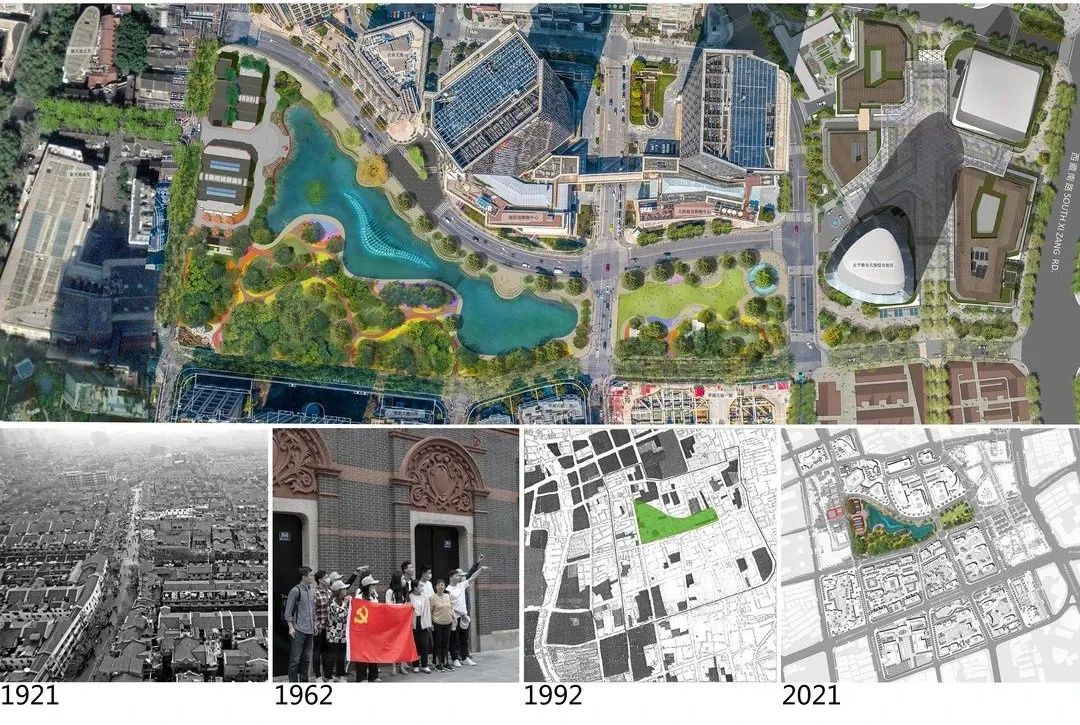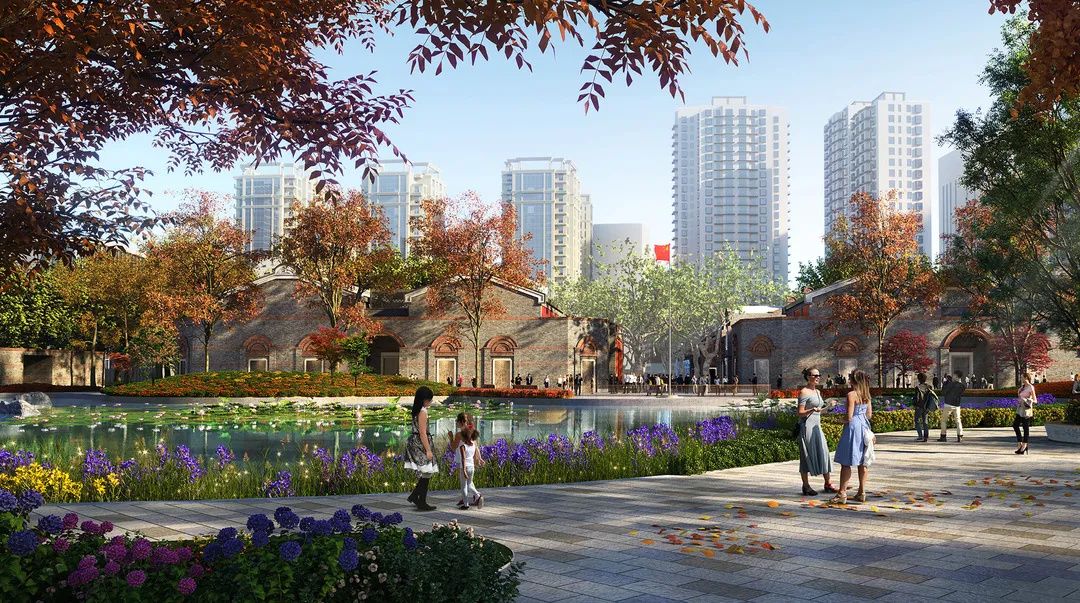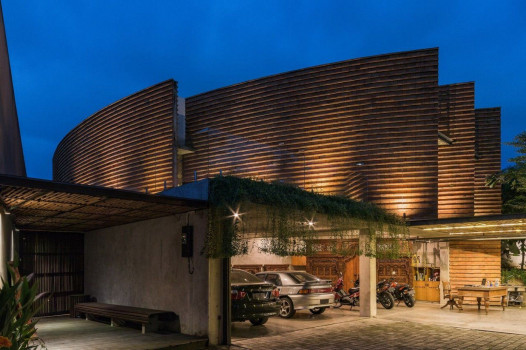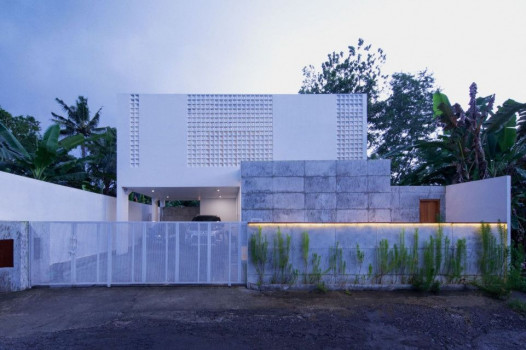A Park Revolutionised



Through layers of change, Taipingqiao Park currently evokes a sense of discovery, promotes healthy communities and quality of life, nurtures curiosity and encourages education within everyday experiences at the heart of an evolving Shanghai.
The redesign and renovation of Taipingqiao Park in Shanghai China, a four hectare park adjacent to Xintiandi in Huangpu District (formally Luwan District), has been transformed, in part due to the introduction of the The Museum of the First CPC National Congress, an extension of the Commemorative Exhibition hall where the First National Congress of the Chinese Communist Party was held on July 23, 1921.
This is a story of urban transformation, a visual narrative demonstrating how the city and it’s urban space evolves over time, designed not by one individual, but born through the momentum of administrative, social, economic and environmental forces and a team of people who celebrate cities and their complexities, contradictions and constraints and promote their continued evolution. This is a story of how cultural heritage can be an asset that can enhance the identity of a place.
The First National Congress of the Chinese Communist Party was held in Shanghai on July 23, 1921 in a Shikumen House, No. 76, Xingye Road (formerly 106, Wangzhi Road) in the (Former French Concession) area of Huangpu District adjacent to present-day Xintiandi. Due to the threat of harassment and a need for more secrecy, the meeting was relocated to a boat on South Lake in Jiaxing to conclude with the establishment of the Chinese Communist Party.
Twelve years after the Chinese Communist Party established the People’s Republic of China, The historical Shikumen house at No. 76, Xingye in Luwan District (currently Huangpu District) was converted into a Museum Hall to commemorate where the 1st National Congress of the Chinese Communist Party was held in Shanghai on July 23 1921. The museum combines historical exhibits of China and Shanghai including the events surrounding the foundation of the Chinese Communist Party that began in this quiet ‘Linong’ lane house.
The ‘365 Plan’, a regeneration program by the Shanghai Government is launched requiring each district government in Shanghai’s city center to propose a location for reconstruction. The profit-driven redevelopment model proved easy to implement but had little regard for the preservation or protection of the urban fabric or the historically significant identity of the city. Nevertheless, a Taipingqiao neighborhood in Luwan District (currently Huangpu District) became the first community that did not follow this model of urban regeneration due to the celebrated significance of the site where the 1st National Congress of the Chinese Communist Party was held. This later resulted into the reconstruction of Xintiandi and creation of Taipingqiao Park. This also helped launch China’s movement towards inner-city preservation and influenced the way city officials and real estate developers view culturally significant historic buildings and neighborhoods.
The master plan design of Taipingqiao is completed and approved by the Shanghai Municipal Government. The The Site of the First CPC National Congress is influential in the planning phase and preservation of a two block area later known as ‘Xintiandi’, a commercial, retail, and entertainment cluster with historic characteristics based on the conservation and utilization of traditional “Shikumen” style architecture in a neighborhood layout known as “Linong”. East and adjacent to Xintiandi a four hectare park is planned with a man-made lake inspired by historic events of 1921 when the First National Congress established the Chinese Communist Party on a boat in Jiaxing South Lake.
Construction of Taipingqiao Park was launched in 2000 and completed in 2001. The areas surrounding each side of the lake are designed with various programs according to Taipingqiao’s overall master plan; the North side, a commercial urban edge bound by the newly created Corporate Avenue has undulating steps that descend in different widths into the water. The South side is the more natural residential border of the park with rolling hills and lush planting. Its West side, the historically preserved district of Xintiandi including the ‘First Congress Hall’, is designated for culture and tourism with the East end of the park, a future landmark commercial high-rise building. A ‘South Lake ‘boat’ linking to the historical First Congress Hall 1921 meeting on a boat on South Lake in Jiaxing was designed but never implemented.
The expansion of The Site of the First CPC National Congress in Taipingqiao Park, to mark China’s 100 year celebration of the founding of the Communist Party of China, initiated the redesign and renovation of Taipingqiao Park, the Museums new home. The design challenges are not new, they are more or less the same type of challenges, albeit now more contemporary, the park has experienced as it evolves since its conception in 1996 into what it is today. Administrative, social, economic and environmental momentums continued to shape the parks overall function and character when new designs initially began in 2019.

.jpg)
.jpg)
.jpg)
.jpg)
2021 challenges
-Segregation and blending of the cultural and commercial -Integrating the park into the current Taipingqiao Master Plan Development -Economics -Aesthetic -Environmental
Segregation and blending of the cultural and commercial
Blending the cultural and commercial has been previously uniquely accomplished with the development of Xintiandi; a retail and entertainment district with historic characteristics based on the conservation and utilization of traditional Shikumen houses in a Linong neighborhood.
The merging of the commercial and cultural in Taipingqiao Park is not entirely much different. New flexible open space to allow the continued hosting of the annual Shanghai Fashion Week and New Year Concerts are redesigned within the parks core to segregate and make room for the new location of the Museum of the First CPC National Congress. Festivities are relocated to an open flexible lawn on the east end of the park for events with room to expand over Jinan Road and the far eastern tip of the lake. A retractable dam has been installed so that only a small part of the lake would be recycled if events spill over.
A long computerized music and light fountain is added in the middle of the lake that could accommodate both commercial and cultural needs depending on the events held.
Master Plan Integration
The master plan design of Taipingqiao as approved by the Shanghai Municipal Government is near completion marking a 25 year span since its inception. Due to continued unpredictable economic and social trends, Taipingqiao has become a much different community today than it was say 10 or 15 years ago as it evolves, as urban space normally do, into the dynamism it is today.
Efforts to connect the park with the new commercial development on its east end, scheduled to be completed in 2024, with Xintiandi and the Museum of the First CPC National Congress are made through the design of connecting water features and the use of consistent paving materials, street trees, a more colorful planting pallet, lighting and a series of built in benches and low sitting walls to accommodate a larger and more outdoor appreciating lunch and evening crowd.
.jpg)
Economics
The balance between budget and the need to invest in enhancing the identity of a place is considered, especially when understanding that more crowds will be attracted to a beautiful park with interactive water features, seasonal color and an important cultural museum.
Zones of investment priorities are set within the park to minimize the overall cost impact with less expensive red brick pavers and open rolling lawns within the residential south end of the park.
Yellow granite paving steps and timber benches for the commercial north end of the park and higher quality stone pavers and mature flowering trees are to commensurate the importance of the Museum of the First CPC National Congress.
_1626244792.jpg)
Aesthetics
The Museum of the First CPC National Congress has become a focal point within Taipingqiao Park with the park and its lake a unique landmark identity for the Taipingqiao master plan.
Over time, Taipingqiao Park has been successfully shaped into one of Shanghai’s foremost inner city urban parks. Colorful paving materials, custom timber benches and low sitting brick walls that encourage social interaction, colorful jumping water features, a seasonal colorful planting pallet and the undulating character of the lake and paths encourages social activities, recreation and entertainment and help emphasize the importance of a city’s quality of life, its health and wellness.
.jpg)
Environmental
A new sensitive and sustainable approach to Taipingqiao Park’s upgrades include the addition of permeable paving materials, farmed hard woods, sustainable drainage systems and a softer, less urban northern edge of the lake. The undulating urban steps that previously dominated the commercial edge are now broken into cascading planting beds with benches that encourage social interaction down to the water line.
Parks are playing an increasingly important role in China’s fast growing urban population. City officials and developers understand that urban parks help bring positive social benefits, increase urban biodiversity, contribute to the reduction of urban heat island effect and improve air and water quality. It makes perfect sense that the the Museum of the First CPC National Congress shares a positive outlook towards the future as the park it sits in.
We are attracted to the best of public spaces, not because we have to go there, but because we want to be there. A great space is one that is representative of the city with its streets, plazas and squares embodying the form and comfort of urban communities. They are settings for activity that bring people together to react and interact to what the built environment has to offer and are places for escape, romance, dreaming, acting and observing. This is exactly what Taipingqiao Park has evolved into over the last 20 years; designed not by one individual, but born through layers of external momentum and a team of people who celebrate cities and their complexities, contradictions and constraints and promote their continued evolution. This is a story of how cultural heritage as an asset can enhance the identity of a place.
.jpg)




 Australia
Australia
 New Zealand
New Zealand
 Philippines
Philippines
 Hongkong
Hongkong
 Singapore
Singapore
 Malaysia
Malaysia








